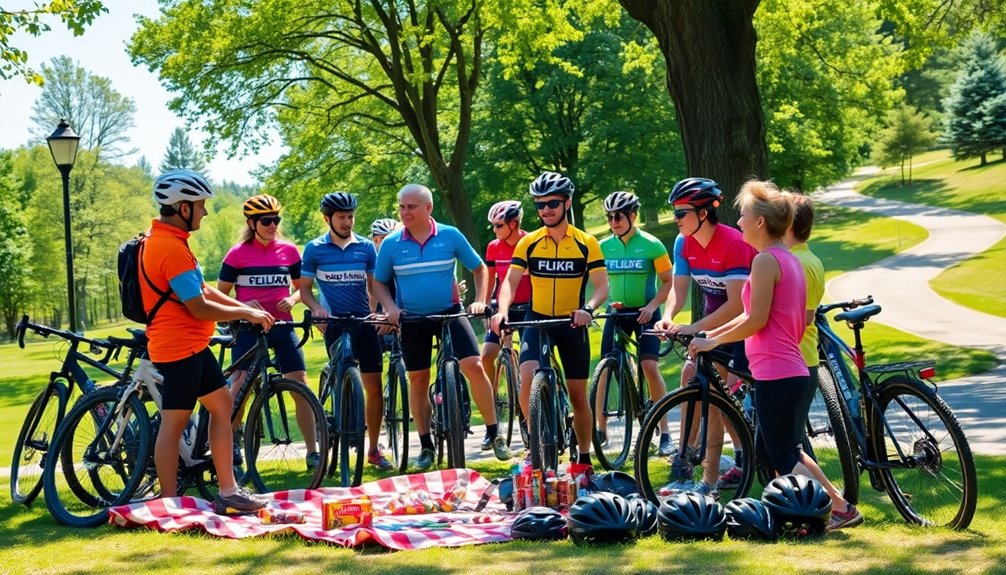To build a cycling community and connect with other riders, join a local cycling club. You'll find a vibrant group of cycling enthusiasts enthusiastic to share experiences and skills. Participate in organized group rides, where you'll not only enjoy the outdoors but also foster friendships. Don't underestimate the power of social media to expand your network and keep everyone informed about rides and events. Keep exploring ways to strengthen these connections; there's more to discover!
Key Takeaways
- Join a local cycling club to access a supportive community and participate in organized rides and events.
- Utilize social media platforms to connect with fellow cyclists, share information, and promote group activities.
- Organize regular group rides of varying distances to encourage participation and foster inclusivity among cyclists.
- Collaborate with local bike shops for joint events and activities that enhance community engagement.
- Prioritize safety during rides by teaching hand signals and wearing visible clothing to ensure enjoyable experiences for all participants.
The Importance of Local Cycling Clubs
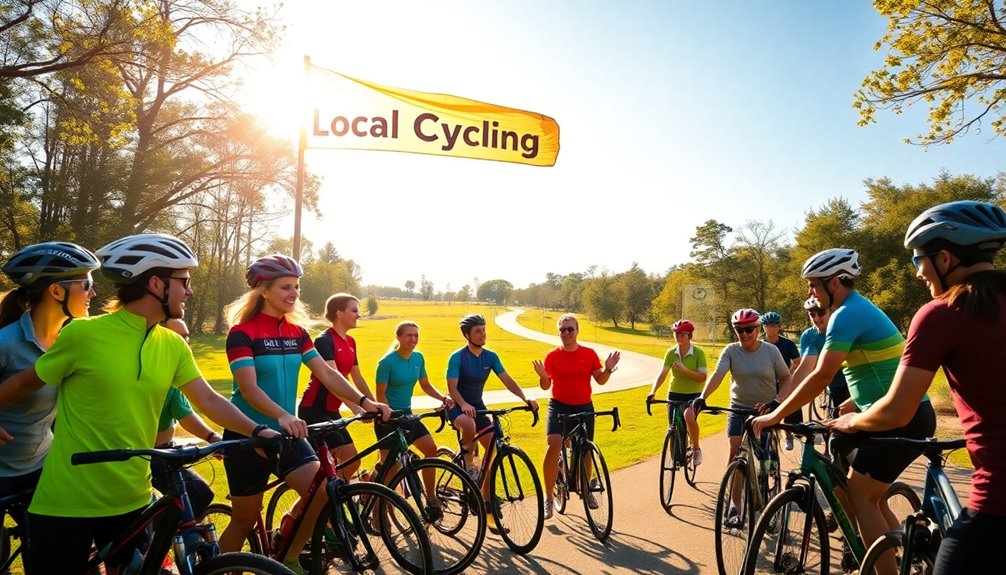
When you join a local cycling club, you're not just signing up for regular rides; you're diving into a vibrant community that shares your passion for cycling.
Local clubs provide a structured environment, catering to both casual and serious cyclists alike. You'll find opportunities to connect with like-minded riders and improve your skills through organized events and high-performance rides.
Participating in these clubs elevates your cycling experience, as you gain access to valuable resources like training tips and racing opportunities.
Joining a cycling club enhances your journey, offering invaluable training tips and exciting racing opportunities.
Furthermore, by engaging in local cycling clubs, you contribute to nurturing the cycling scene in your area, helping to attract more dedicated cyclists.
These clubs often collaborate with bike shops, strengthening community ties and supporting safer biking infrastructure. Additionally, joining a local cycling club can enhance your overall personal and community resilience, enabling you to better navigate challenges and enjoy cycling together more effectively.
Engaging With Fellow Cyclists
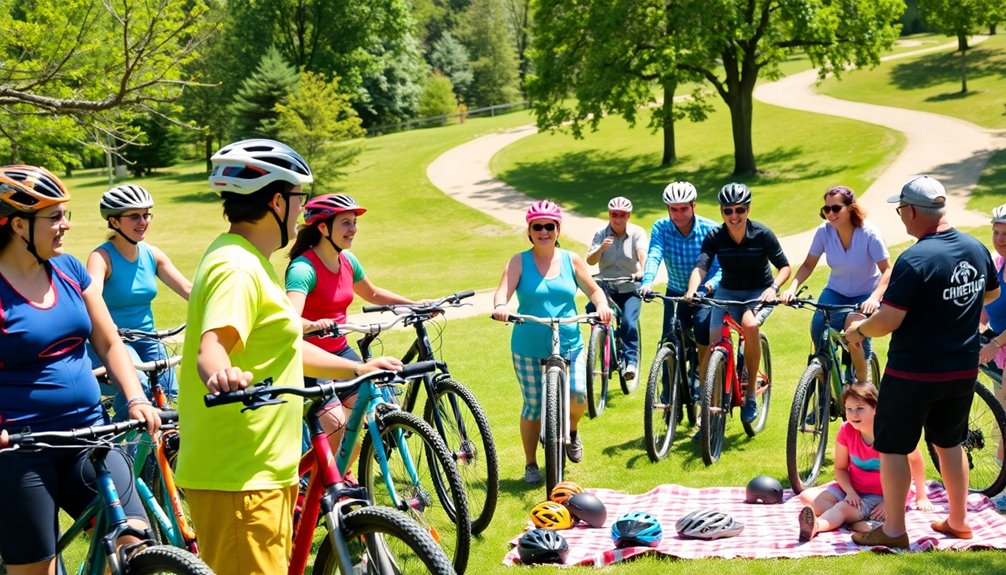
Joining local group rides is a fantastic way to meet fellow cyclists and share your passion for biking.
You'll not only enjoy the camaraderie of riding together, but you can also connect with online cycling communities to expand your network.
These interactions can lead to lasting friendships and memorable experiences on and off the bike.
Local Group Rides
Local group rides offer a fantastic way to connect with fellow cyclists, creating an environment where you can learn from experienced riders and build friendships.
Scheduling regular rides, like weekly or bi-weekly meet-ups, establishes a sense of community that attracts both casual and competitive cyclists. You can utilize your local bike shop to promote these rides, as many cyclists use shops as informal meeting points.
Engaging with local cycling clubs also opens doors to organized rides catering to various skill levels, making it easier for beginners to join.
Don't forget to encourage social interactions during and after rides, such as hosting post-ride coffee gatherings. These moments enhance your community experience and help foster lasting relationships among fellow cyclists.
Online Cycling Communities
Connecting with fellow cyclists doesn't stop at group rides; online cycling communities also play an essential role in fostering relationships and sharing experiences.
By utilizing social media and online platforms, you can connect with like-minded individuals who share your passion for cycling. Use hashtags related to cycling to discover specific communities and events, enhancing your network.
Engaging in online forums dedicated to cycling allows for valuable knowledge-sharing and discussions that elevate your riding experience. Apps like Komoot make ride planning and tracking easier while helping you discover public rides nearby.
Virtual rides and challenges strengthen camaraderie among cyclists, offering a space for competition and community building, even when you can't meet in person.
Embrace the power of online cycling communities!
Organizing Regular Group Rides
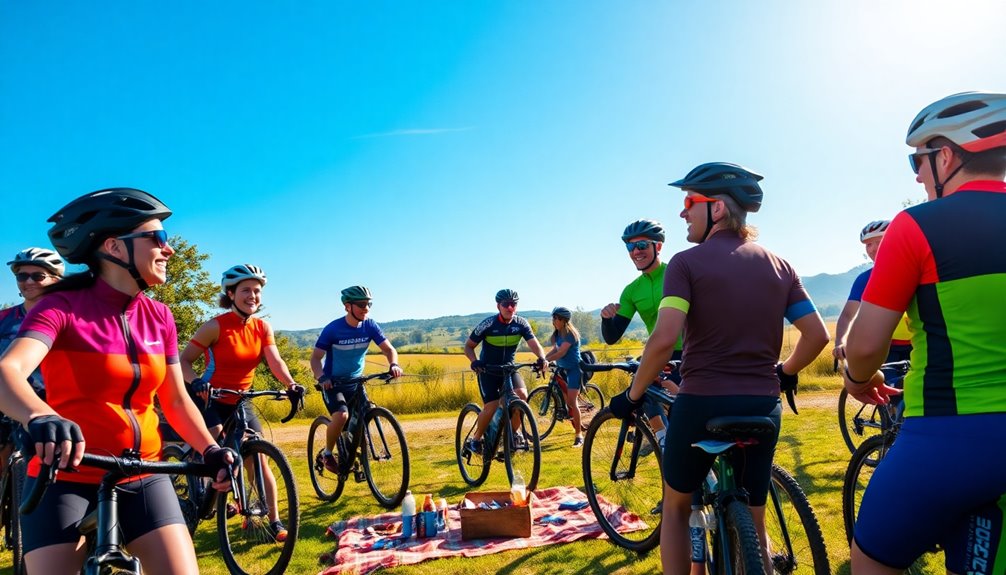
To build a strong cycling community, you need to establish a consistent ride schedule that everyone can count on.
By offering rides of varying distances and difficulty levels, you'll promote inclusivity and guarantee that cyclists of all skill sets feel welcome.
Don't forget to create a supportive environment where safety is a top priority, helping everyone enjoy their time on the road.
Scheduling Consistent Rides
Establishing a regular ride schedule is essential for building a vibrant cycling community. Start with one group ride per week to create consistency and encourage participation.
To accommodate everyone, plan rides 30-60 minutes later than the advertised time, ensuring both early risers and latecomers can join comfortably. Use email notifications two days before each ride, detailing the starting time, location, cue sheets, and ride statistics to keep everyone informed.
Foster a relaxed atmosphere during rides to promote social interaction, enhancing the experience for all cyclists.
Finally, incorporate diverse ride options that cater to different skill levels, allowing beginners and experienced riders to ride together, ultimately strengthening your cycling community and making it more welcoming for all.
Promoting Inclusivity and Safety
While organizing regular group rides can seem intimidating, it's a fantastic way to promote inclusivity and safety within your cycling community. By offering diverse ride options for different skill levels, you guarantee that both beginners and experienced cyclists feel welcome.
Establishing a clear ride schedule encourages participation and builds camaraderie among members. Implementing a "no-drop" policy allows everyone to ride at a comfortable pace, enhancing safety and enjoyment.
Providing safety instructions and teaching basic hand signals during group rides helps participants communicate effectively, reducing the risk of accidents. Additionally, organizing themed rides, such as seasonal themes, can generate excitement and attract new members.
Finally, incorporating social activities like post-ride gatherings strengthens bonds, creating a friendly atmosphere that encourages new riders to join and feel included. Together, these elements foster a supportive cycling community.
Utilizing Social Media for Connections
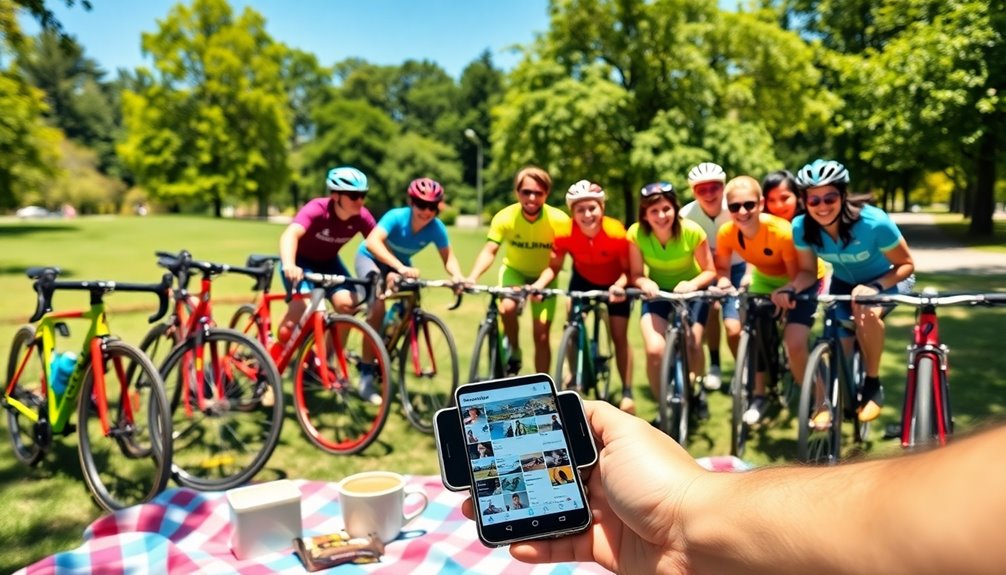
Social media can be a powerful tool for connecting cyclists, especially when you leverage dedicated group pages on platforms like Facebook. By joining or creating cycling clubs online, you can share information about upcoming events and engage with fellow riders.
Using specific hashtags related to cycling helps you locate niche communities and events, enhancing your visibility. You can also participate in virtual rides and challenges organized through social media, fostering competition and camaraderie with others who share your passion.
Online forums and cycling groups provide fantastic opportunities for knowledge-sharing and discussions, allowing you to learn from other cyclists.
Don't forget to engage with local bike shops on social media, promoting club activities and attracting new members through their community ties.
Safety Considerations for Group Rides
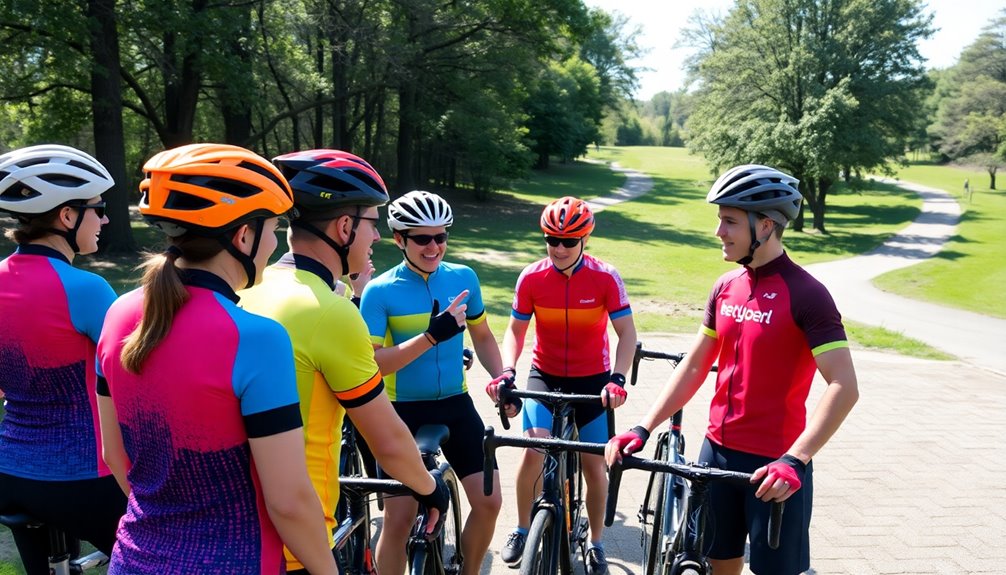
When organizing group rides, it is vital to prioritize safety to guarantee everyone enjoys the experience without unnecessary risks. Remember, potential liability issues can arise if injuries occur, so consider obtaining liability insurance and using waivers. Teach participants basic hand signals for hazard alerts, and make sure everyone wears highly visible clothing, especially at night. Additionally, implement a backup plan for emergencies.
| Safety Measure | Description | Importance |
|---|---|---|
| Liability Insurance | Protects against claims | Reduces financial risks |
| Hand Signals | Communicate hazards | Enhances rider awareness |
| Visible Clothing | Increases visibility | Reduces accident risk |
| Emergency Contact Plan | Quick response to incidents | Guarantees participant safety |
Planning Inclusive Routes for All Skill Levels
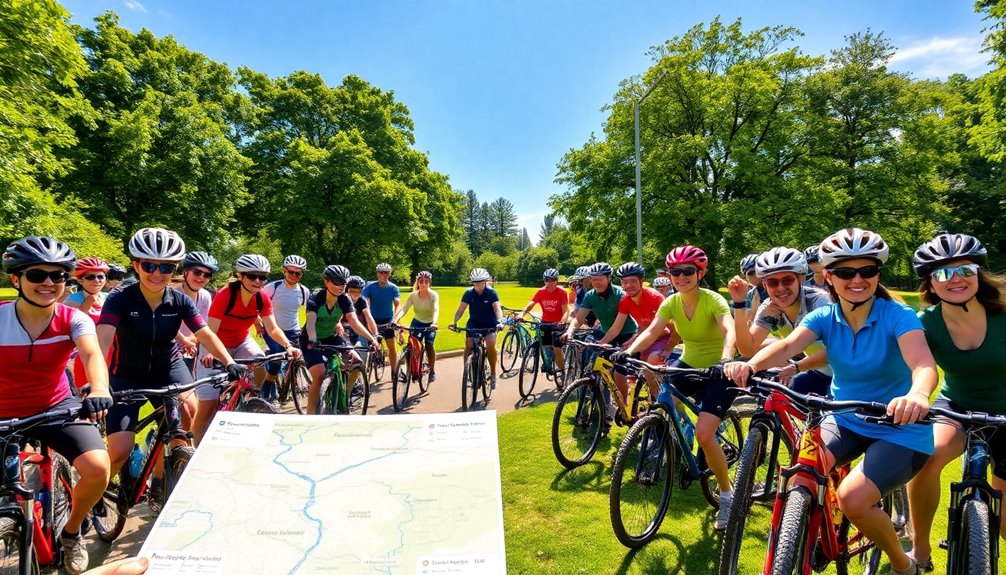
Planning inclusive routes for all skill levels is essential for fostering a welcoming cycling community. When organizing club rides, aim for a distance of around 10 miles, with a planned rest stop midway to accommodate everyone.
Planning inclusive routes for all skill levels fosters a welcoming cycling community, ensuring enjoyable rides for everyone involved.
Establish a designated pace of about 12 mph for casual rides to maintain group cohesion and prevent faster riders from straggling. Consider offering shorter ride options for families and less experienced cyclists, promoting inclusivity within your community.
Use GPS cycling apps like Strava or Ride With GPS to map out safe, scenic routes while monitoring road conditions for rider safety. Additionally, ensure that your routes are free from steep inclines to minimize the risk of changing gears becoming a challenge for less experienced riders.
Always communicate ride details, such as average speed and ride structure, to set clear expectations and guarantee everyone feels comfortable participating.
Building Relationships Through Social Events
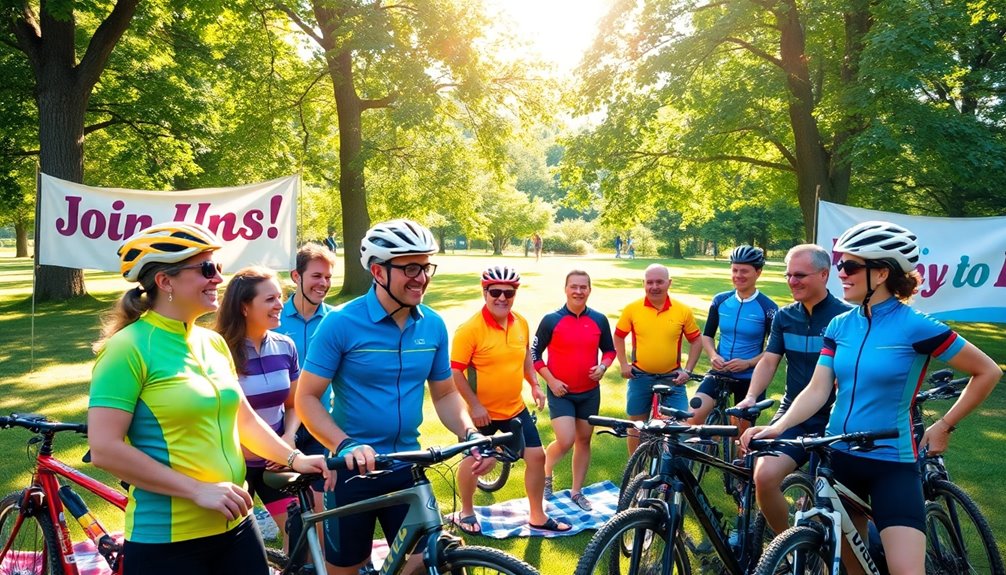
Organizing social gatherings like post-ride drinks or coffee meet-ups can really help you connect with fellow cyclists.
Collaborative riding events not only boost your visibility in the community but also create fun opportunities for social interaction.
Engaging in these activities builds stronger relationships and a more vibrant cycling community.
Organizing Social Gatherings
Building relationships within a cycling community often thrives through social gatherings that bring members together beyond their rides. Organizing post-ride meetups for drinks or coffee is a great way to enhance camaraderie and foster lasting connections.
Consider hosting non-cycling activities, like educational meetings or fun events, to strengthen bonds and encourage participation in local cycling happenings. Collaborating with local bike shops for joint social gatherings can boost visibility and attract new members.
Creating a welcoming atmosphere at these events fosters inclusivity, making it easier for newcomers to engage. Regularly scheduled social gatherings provide consistent opportunities for cyclists to connect, share experiences, and deepen their ties within the community, making everyone feel like they belong. Engaging in these activities can lead to transformative life changes as members find support and inspiration from one another.
Collaborative Riding Events
Joining forces for collaborative riding events can greatly enhance the sense of community among cyclists. Organizing regular group rides fosters social interaction and camaraderie, making it easier for you to connect with fellow riders.
Consider hosting post-ride gatherings at local coffee shops or bars; these moments encourage relationships to deepen beyond cycling. Partnering with local bike shops can boost your visibility, attracting new participants to your rides.
Utilize platforms like Facebook to create dedicated event pages, promoting your group rides and facilitating communication among cyclists. Additionally, incorporating non-cycling activities, such as educational meetings or social gatherings, can strengthen bonds and foster a true sense of belonging within the cycling community.
Collaborating With Local Bike Shops

When you connect with local bike shops, you tap into a wealth of knowledge and resources that can elevate your cycling community.
Connecting with local bike shops unlocks valuable insights and resources to enhance your cycling community.
These shops are more than just places to buy gear; they're hubs for cyclists.
Here are some ways to collaborate:
- Discover nearby biking groups and clubs through the shop's insights.
- Join regular rides and events they host for networking.
- Get staff recommendations for community engagement.
- Use the shop as a meeting point to share experiences and plan outings.
- Explore sponsorship opportunities that benefit both the shop and your cycling club.
Participating in Community Advocacy Efforts
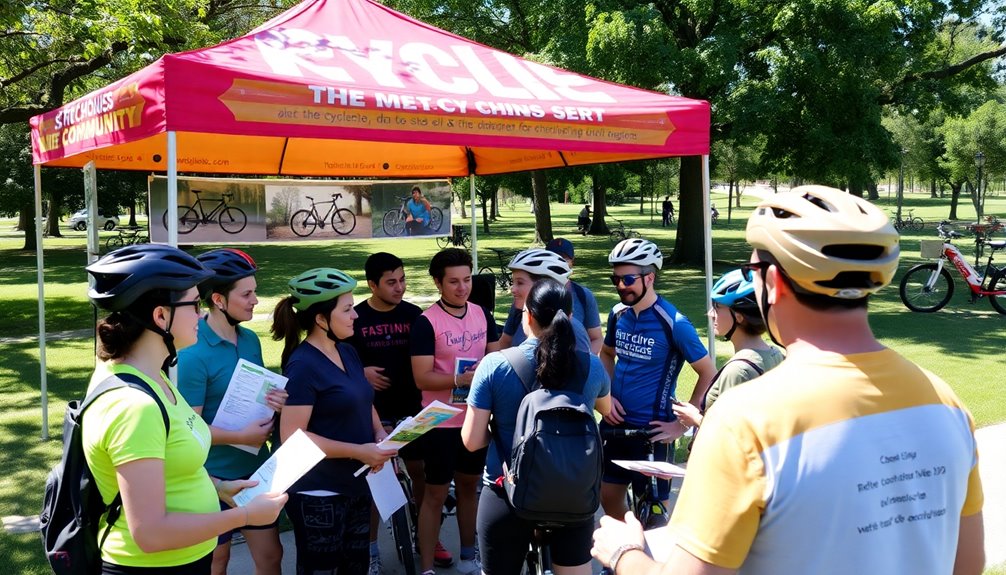
Connecting with local bike shops not only strengthens your cycling community but also opens doors for community advocacy efforts.
By joining local bike coalitions, you can enhance your involvement and enjoy benefits like discounts at bike shops and organized rides.
Participate in community meetings to voice biking needs and collaborate on solutions to improve local cycling infrastructure.
Additionally, consider collaborating with local businesses for sponsorships; this can provide essential resources for your advocacy initiatives.
Utilize social media to spread the word about biking events and issues, engaging a wider audience.
Finally, track participation rates in events and conduct surveys to measure community satisfaction, informing your cycling clubs on future advocacy strategies and initiatives.
Nurturing a Supportive Cycling Environment
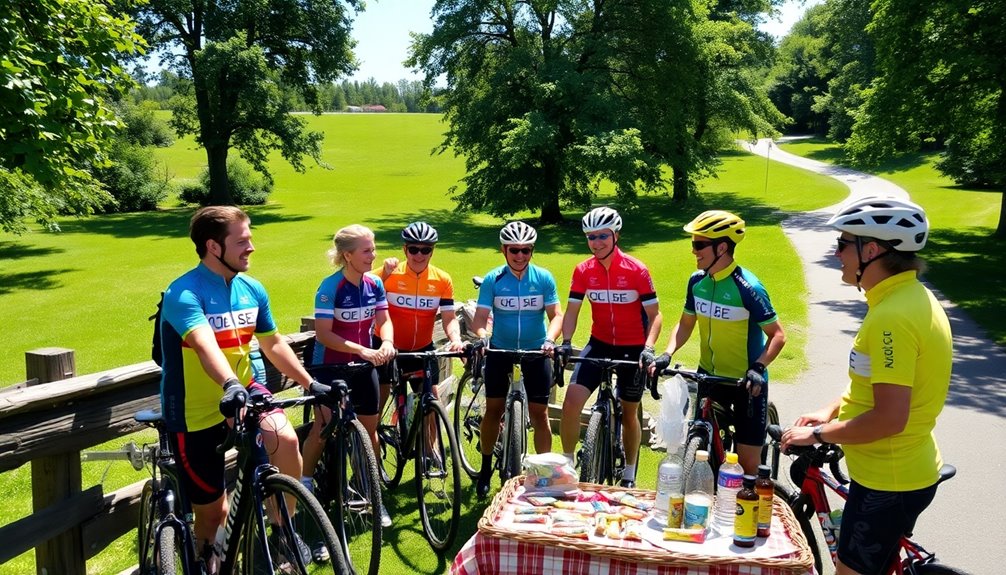
Creating a supportive cycling environment not only fosters growth but also attracts cyclists of all skill levels. By prioritizing collaboration over competition, you can build a thriving community.
Here are some ways to nurture this atmosphere within your cycling groups:
- Engage with beginners, offering mentorship and guidance.
- Host non-cycling activities, like picnics or workshops, to strengthen bonds.
- Schedule regular group rides to encourage consistent participation.
- Organize social events to enhance camaraderie among members.
- Cultivate a culture that values shared experiences and social interaction.
When members feel welcomed and supported, they'll be more likely to stick around, making your cycling group a vibrant and dynamic space for everyone involved.
Frequently Asked Questions
What Is the 75 Rule in Cycling?
The 75 Rule in cycling recommends that you spend 75% of your training time at a lower intensity to build endurance, while the remaining 25% should focus on higher intensity efforts.
This balance helps improve your overall performance without risking burnout. By incorporating easy rides alongside tempo sessions or intervals, you'll enhance your speed and power while minimizing the risk of injury.
It's a versatile approach suitable for all cycling disciplines.
How to Communicate With Another Bike Rider?
"Two heads are better than one." When you're riding with another cyclist, clear communication is key.
Use voice commands to call out hazards or instructions, keeping everyone informed. Establish hand signals for turns, slowing down, or obstacles to enhance non-verbal communication.
Don't forget to check in during breaks to share experiences and build rapport. Group texting apps can also help you coordinate rides and keep everyone updated on changes or plans.
How Do You Build a Cycling Community?
To build a cycling community, start by connecting with local cyclists through clubs and bike shops.
Organize regular group rides that welcome all levels, allowing newcomers to meet experienced riders.
Utilize social media to promote events and create virtual challenges that engage members.
Collaborate with local advocacy groups to address safety and infrastructure needs.
How Do I Meet Other Cyclists?
To meet other cyclists, consider connecting with local clubs, where camaraderie and competition coexist.
Attend races and events to encounter enthusiastic, like-minded riders.
Join social media groups or cycling apps to discover nearby biking buddies.
Don't forget your local bike shop—they often host rides and gatherings that can spark friendships.
Conclusion
By engaging with fellow cyclists and participating in local events, you'll not only enhance your riding experience but also foster a vibrant cycling community. For example, joining a local cycling club might lead to a weekend group ride that turns into lifelong friendships and shared adventures. Embrace these connections, advocate for cycling in your community, and watch how your passion for cycling transforms into a supportive network that keeps everyone motivated and safe on the road.
